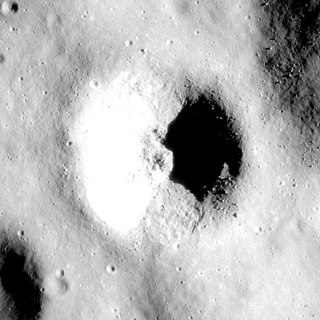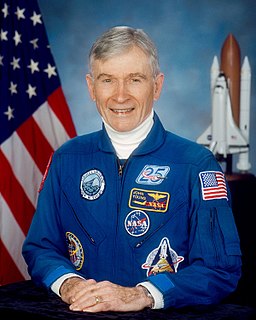 W
WApollo 16 was the tenth crewed mission in the United States Apollo space program, administered by NASA, and the fifth and next-to-last to land on the Moon. It was the second of Apollo's "J missions", with an extended stay on the lunar surface, a focus on science, and the use of the Lunar Roving Vehicle (LRV). The landing and exploration were in the Descartes Highlands, a site chosen because some scientists expected it to be an area formed by volcanic action, though this proved to not be the case.
 W
WLunar Sample 61016, better known as "Big Muley", is a lunar sample discovered and collected on the Apollo 16 mission in 1972 in the Descartes Highlands, on the rim of Plum crater, near Flag crater. It is the largest sample returned from the Moon as part of the Apollo program. The rock, an 11.7 kg (26 lb) breccia consisting mainly of shocked anorthosite attached to a fragment of troctolitic "melt rock", is named after Bill Muehlberger, the Apollo 16 field geology team leader.
 W
WCinco is a small crater in the Descartes Highlands of the Moon visited by the astronauts of Apollo 16. The crater is one of a group of five craters that were collectively called the Cinco craters during the Apollo 16 mission. The craters were designated a, b, c, d, and e, and the largest (a) was officially named Cinco after the mission in 1973 by the IAU.
 W
WThe Descartes Highlands is an area of lunar highlands located on the near side that served as the landing site of the American Apollo 16 mission in early 1972. The Descartes Highlands is located in the area surrounding Descartes crater, after which the feature received its name.
 W
WCharles Moss Duke Jr. is an American former astronaut, United States Air Force (USAF) officer and test pilot. As lunar module pilot of Apollo 16 in 1972, he became the tenth and youngest person to walk on the Moon, at age 36 years and 201 days.
 W
WFlag crater is a small crater in the Descartes Highlands of the Moon visited by the astronauts of Apollo 16. The name of the crater was formally adopted by the IAU in 1973. Geology Station 1 is adjacent to Flag, at the much smaller Plum crater.
 W
WThe Lunar Roving Vehicle (LRV) is a battery-powered four-wheeled rover used on the Moon in the last three missions of the American Apollo program during 1971 and 1972. It is popularly called the Moon buggy, a play on the term dune buggy.
 W
WThomas Kenneth Mattingly II is an American former aviator, aeronautical engineer, test pilot, rear admiral in the United States Navy and astronaut who flew on the Apollo 16, STS-4 and STS-51-C missions.
 W
WNorth Ray crater is a small crater in the Descartes Highlands of the Moon visited by the astronauts of Apollo 16. The name of the crater was formally adopted by the IAU in 1973. It is the largest crater sampled by astronauts during the Apollo program.
 W
WPalmetto crater is a small crater in the Descartes Highlands of the Moon visited by the astronauts of Apollo 16. The name of the crater was formally adopted by the IAU in 1973.
 W
WSouth Ray crater is a small crater in the Descartes Highlands of the Moon photographed from the lunar surface by the astronauts of Apollo 16. The name of the crater was formally adopted by the IAU in 1973.
 W
WSpook crater is a small crater in the Descartes Highlands of the Moon visited by the astronauts of Apollo 16. The name of the crater was formally adopted by the IAU in 1973. Geology Station 2 is adjacent to Spook, between it and the smaller, younger crater called Buster to the north of it.
 W
WJohn Watts Young was an American astronaut, naval officer and aviator, test pilot, and aeronautical engineer. He became the ninth person to walk on the Moon as commander of the Apollo 16 mission in 1972. He flew on four different classes of spacecraft: Gemini, the Apollo command and service module, the Apollo Lunar Module, and the Space Shuttle.